

Copper ale is a style of ale known in part for its copper color. [1]
Contents
Some varieties of copper ale may be produced to have a bitter flavor, [2] such as that of a bitter. Beer brewed with dark malt may contribute to a copper-colored beer. [3]


Copper ale is a style of ale known in part for its copper color. [1]
Some varieties of copper ale may be produced to have a bitter flavor, [2] such as that of a bitter. Beer brewed with dark malt may contribute to a copper-colored beer. [3]
Copper ale is the flagship beer of Otter Creek Brewing, a craft brewery located in Middlebury, Vermont. [4] It is also produced by other U.S. companies, such as Boulder Beer Company in Boulder, Colorado. [1] [5]
In Australia, the James Squire brand of copper ale named The Constable Copper Ale was produced. [6] It was retired from production in 2017. [7] It is also produced by Alosta Brewing Company in Covina, California, in collaboration with the band +LĪVE+ to celebrate their 8× platinum album Throwing Copper .
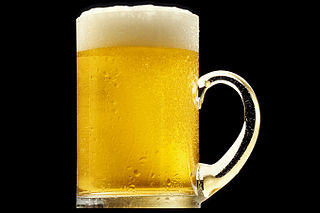
Beer is one of the oldest types of alcoholic drinks in the world, and the most widely consumed. It is the third most popular drink overall after potable water and tea. It is produced by the brewing and fermentation of starches, mainly derived from cereal grains—most commonly malted barley, though wheat, maize (corn), rice, and oats are also used. During the brewing process, fermentation of the starch sugars in the wort produces ethanol and carbonation in the resulting beer. Most modern beer is brewed with hops, which add bitterness and other flavours and act as a natural preservative and stabilising agent. Other flavouring agents such as gruit, herbs, or fruits may be included or used instead of hops. In commercial brewing, the natural carbonation effect is often removed during processing and replaced with forced carbonation.

Mild ale is a type of ale. Modern milds are mostly dark-coloured, with an alcohol by volume (ABV) of 3% to 3.6%, although there are lighter-hued as well as stronger milds, reaching 6% abv and higher. Mild originated in Britain in the 17th century or earlier, and originally meant a young ale, as opposed to a "stale" aged or old ale.

Pale ale is a golden to amber coloured beer style brewed with pale malt. The term first appeared in England around 1703 for beers made from malts dried with high-carbon coke, which resulted in a lighter colour than other beers popular at that time. Different brewing practices and hop quantities have resulted in a range of tastes and strengths within the pale ale family.

P. Ballantine and Sons Brewing Company was an American brewery founded in 1840, making Ballantine one of the oldest brands of beer in the United States. At its peak, it was the 3rd largest brewer in the US. The brand is currently owned and operated by Pabst Brewing Company. Throughout history it is best known for its Ballantine XXX Ale; however, in August 2014 Ballantine IPA relaunched and has been received with mixed reviews. Ballantine is Pabst's foray into the craft beer market.
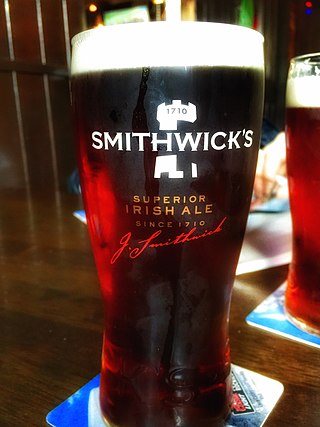
Irish red ale, also known as red ale or Irish ale, is a style of pale ale that is brewed using a moderate amount of kilned malts and roasted barley, giving the beer its red colour. Its strength typically ranges from 3.8% to 4.8% alcohol by volume, although some craft varieties can be as high as 6%.
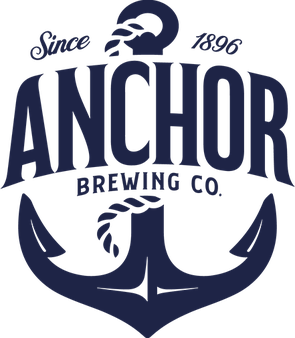
Anchor Brewing Company was a brewery on Potrero Hill in San Francisco, California. Founded in 1896, the brewery has undergone several changes in location and ownership throughout its history. After years of declining sales due to competition with larger breweries, Anchor was purchased by Frederick Louis “Fritz” Maytag III in 1965, preventing its closure. The brewery operated at its current location since 1979 and was one of the last remaining producers of steam beer, a variety of beer trademarked by the company.

India pale ale (IPA) is a hoppy beer style within the broader category of pale ale.
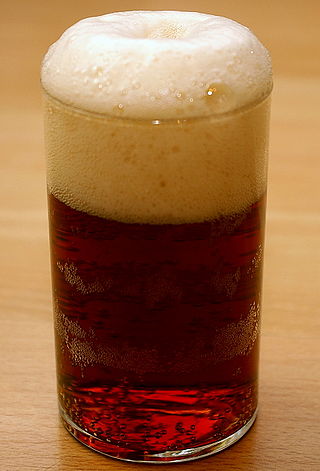
Altbier is a style of beer brewed in the Rhineland, especially around the city of Düsseldorf, Germany. It is a copper coloured beer whose name comes from it being top-fermented, an older method than the bottom fermentation of lagers.

Bitter is an English style of pale ale that varies in colour from gold to dark amber, and in strength typically from 3% to 5.5% alcohol by volume.

,

Beer is manufactured by more than 7,000 breweries in the United States, which range in size from industry giants to brew pubs and microbreweries. The United States produced 196 million barrels (23.0 GL) of beer in 2012, and consumes roughly 28 US gallons (110 L) of beer per capita annually. In 2011, the United States was ranked fifteenth in the world in per capita consumption, while total consumption was second only to China.
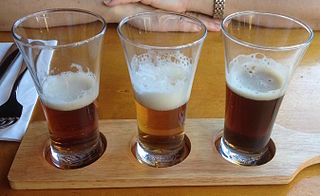
Beer styles differentiate and categorise beers by colour, flavour, strength, ingredients, production method, recipe, history, or origin.
Oskar Blues Brewery is a craft brewery with locations in Longmont, Colorado, Brevard, North Carolina, and Austin, Texas. The company began as a brewpub in Lyons, Colorado in 1997 and began brewing beer in the basement in 1999. In 2002, they became one of the first to put their own craft beer in cans. In 2012, they began marketing some of their craft beer in resealable aluminum containers, and in 2012, they expanded and established another brewery in Brevard, North Carolina.

Real Ale Brewing is a regional-sized American brewery founded in 1996 in Blanco, Texas. Their beers can only be found in Texas.

The Malt Shovel Brewery is an Australian brewery owned by Lion, a subsidiary of the Japanese conglomerate Kirin. It is located in Camperdown, New South Wales. Malt Shovel is best known for its James Squire range of beers. The beer is named after the convict turned Australia's first brewer James Squire, who also went on to grow Australia's first hops and is said to have created Australia's first commercial brewery.

Pumpkin ale is a popular style of beer in the United States. Pumpkin ale may be produced using pumpkin flesh in combination with malt or other more typical beer grains as a portion of the mash bill, contributing fermentable sugars to the wort. It may also be produced by adding natural or artificial flavor to a finished beer. Spice flavor may be added to evoke the flavor of pumpkin pie, a popular American wintertime dessert.

Dragonmead is a U.S. microbrewery, meadery and brewpub founded by Earl Scherbarth, Larry Channell, and Bill Wrobel in January 1997. The small brewery produces many varieties of beer, wine, and mead, and has received awards including gold medals at the World Beer Cup.
A seasonal beer is a beer that is typically brewed during or for a particular season, holiday or festival period. Many breweries and microbreweries produce seasonal beers. Seasonal beers may be produced when fresh ingredients are available during various seasons, per climatic conditions during the time of the year, and also as a tradition. Furthermore, seasonal beer is produced based upon seasons, holidays, festivals and events.

Experimental beer is beer that is produced in or as a new style, using a new recipe, or as a type of beer that does not fit within present beer style criteria or definitions. The term also encompasses minor beer styles that are not covered under any of the Beer Judge Certification Program (BJCP) categories, with the exception of Belgian beers. Such minor beer styles may serve "as an incubator" for new potential categories, and may attain an official category if the style becomes of interest to the general public at a sufficient level. The Great American Beer Festival has an experimental beer category as a part of its competition, for which awards are given, as does the World Beer Cup, which also provides awards for beers in this category. The Oregon State Fair has a home brew competition that includes a category for specialty and experimental beers.

Ale is a type of beer brewed using a warm fermentation method, resulting in a sweet, full-bodied and fruity taste. Historically, the term referred to a drink brewed without hops.